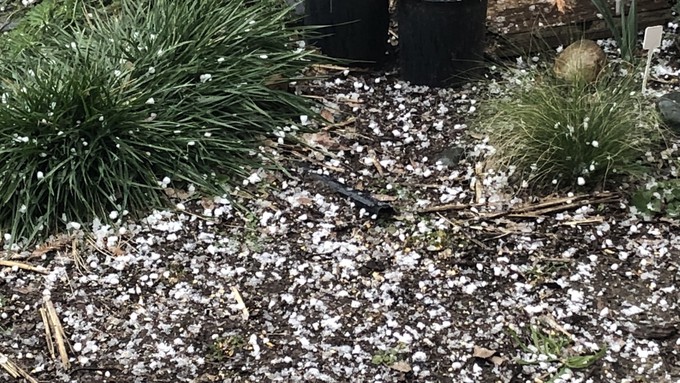
Unusual cold weather inspires some meteorological education

Graupel accumulates on soil and plants Wednesday in northern Carmichael. Kathy Morrison
The white stuff falling from the sky looked like hail, but it didn't bounce. When I picked it up, the little pellets were soft and mushy, not hard. It didn't seem to be snow, either. What was this?
The National Weather Service in Sacramento came to the rescue with the answer: It's graupel. (That's a Germanic word, a diminutive of Graupe, meaning "pearl barley," Merriam-Webster says.)
On its Facebook page, the NWS explained: Graupel is composed of snowflakes that collect supercooled water droplets on their outer surfaces. It forms "when it's very cold aloft but there are above-freezing temperatures at the surface."
If it's soft/wet, it's graupel. If it's hard/solid, it's hail, the weather service says.
Hail, by the way, is defined as frozen raindrops of ice from thunderstorms. It forms "in strong upward winds in thunderstorms" then falls to the ground before melting.
Sleet is another thing: At ground level, sleet is only common during winter storms when falling snow hits a layer of warm air and starts to melt. The resulting droplets hit a deep layer of cold air just above the surface and refreeze into sleet before hitting the ground.
Having read up on graupel, I went down a meteorological rabbit hole of cold-weather terms. (I'm a California kid -- I didn't grow up knowing this stuff.) Here are some of the more interesting ones I found, thanks to the National Weather Service, the National Severe Storms Laboratory and other weather sources.
-- Freezing rain. Subtly different than sleet, it occurs when snowflakes descend into a warmer layer of air and melt completely. When these liquid water drops fall through another thin layer of freezing air just above the surface, they don't have enough time to refreeze before reaching the ground. Because they are “supercooled,” they instantly refreeze upon contact with anything that that is at or below 32 degrees F, creating a glaze of ice on everything. Side note: A significant accumulation of freezing rain lasting several hours or more is called an ice storm.
-- Ice fog. This is a type of fog consisting of fine ice crystals suspended in the air; it's apparently rare except for the coldest parts of the world. More common is a freezing fog, which occurs when liquid fog droplets freeze to surfaces.
-- Pogonip. Another term (of Native American origin) for ice fog.
-- Sea smoke. This occurs when freezing winds flow across warmer water, causing fog to rise up and create a swirly wall. Sea smoke can resemble a giant wave.
-- Snow devil. Like a dust devil, it involves swirling air. It forms when snow is raised from the ground in the form of a whirling column of varying height with a small diameter and an approximately vertical axis. Also called a "snownado."
-- Thundersnow. According to the NWS, this is caused by an intense updraft that creates hail and super-cold water droplets, leading to snow being the primary precipitation rather than rain.
Stay safe and warm, gardeners, whatever weather you encounter this weekend. The garden will survive.
Comments
0 comments have been posted.Sacramento Digs Gardening to your inbox.
Sites We Like
Garden Checklist for week of July 21
Your garden needs you!
* Keep your vegetable garden watered, mulched and weeded. Water before 8 a.m. to reduce the chance of fungal infection and to conserve moisture.
* Feed vegetable plants bone meal, rock phosphate or other fertilizers high in phosphate to stimulate more blooms and fruiting. (But wait until daily high temperatures drop out of the 100s.)
* Don’t let tomatoes wilt or dry out completely. Give tomatoes a deep watering two to three times a week.
* Harvest vegetables promptly to encourage plants to produce more. Squash especially tends to grow rapidly in hot weather. Keep an eye on zucchini.
* Pinch back chrysanthemums for bushy plants and more flowers in September.
* Remove spent flowers from roses, daylilies and other bloomers as they finish flowering.
* Pinch off blooms from basil so the plant will grow more leaves.
* Cut back lavender after flowering to promote a second bloom.
* It's not too late to add a splash of color. Plant petunias, snapdragons, zinnias and marigolds.
* From seed, plant corn, pumpkins, radishes, winter squash and sunflowers.